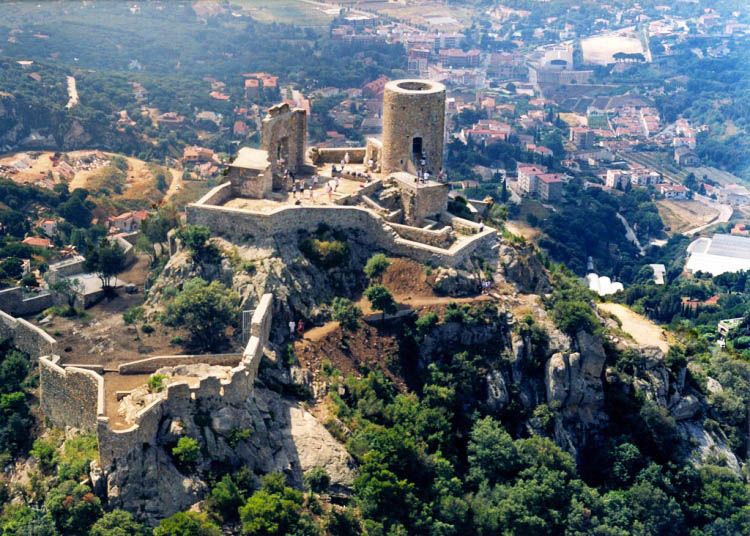

Introduction (Nº0)
Welcome from the Tourism Information Service at Cabrera de Mar. This audioguide will show you the highlights of the city.
Cabrera de Mar is a municipality in the Maresme region and is situated about 28 kilometres from Barcelona, between Vilassar de Mar and Mataró. The town centre is 2.5 kilometres from the sea and 104 metres above sea level in a small valley between two mountains, Burriac y Montcabrer, and its coastline stretches for 1.200 metres with four fine, golden sand beaches.
Traditionally the economy has been based on agriculture, predominantly horticultural products, although from the early 20th century industry also grew in importance thanks to the town’s proximity to Mataró.
As for the historical origins of Cabrera de Mar, early inhabitants belonged to the Iberian people-nation of the Laietans, who controlled territory between the Garraf Massif to the south, the Tordera River delta to the north and the coastline mountain range. The settlement at Burriac acted as the territory’s capital and although it began to be occupied in the 6th century BC it wasn’t until closer to the 4th century BC that it began to take on its political significance and when they built its ramparts and network of streets. The settlement covered an area of between 7 and 10 hectares and is one of the country’s largest Iberian urban centres. The Burriac settlement maintained its political dominance and economic power, based upon the control of wheat production centres on the Vallés plain, until the end of the 3rd century BC.
The Laietan political and economic structure changed radically after the Second Punic War between Carthage and Rome (218 - 206 BC) because the Iberian settlements in the Vallés plain, which were dependent on Burriac, were abandoned and they ceased to use the ancient necropolis in the valley of Cabrera de Mar. It was then that Rome began developing a new urban settlement at the heart of the Cabrera valley to turn it into the political, administrative and economic centre of the ancient Iberian Laietan state. This settlement, which covered a minimum of 3 hectares, minted coins stamped with the Iberian legend of ILTURO. Excavations have helped identify part of its street network as well as important public as well as private buildings.
Clos de Can Benet (Nº1)
Refurbishment work carried out in the municipal sports zone exposed the ruins of a huge stately house which belonged to the Roman Republican era. It was paved with mosaics developed on a base of mortar and ground ceramics, and in one case also on mortar and iron slag. You can see photographs at the end of the site of the mosaic paving belonging to this noble domus and which were discovered under the adjacent street.
The architectural style and decorative motifs created with white and black tesserae forming lines, rhombuses, squares and combinations of swastikas is typical of central and southern Italy in the 2nd century BC. Judging by the size of the rooms, one must assume it was the residence of one of the settlement’s very important members. He would have been Italian and possibly carried out political and administrative duties for the Roman Republic in this territory.
At the entrance to Clos de Can Benet you can also find with the audioguide a visitor’s reception centre where the history of the Cabrera Valley in the Iberian and Roman era is fully explained.
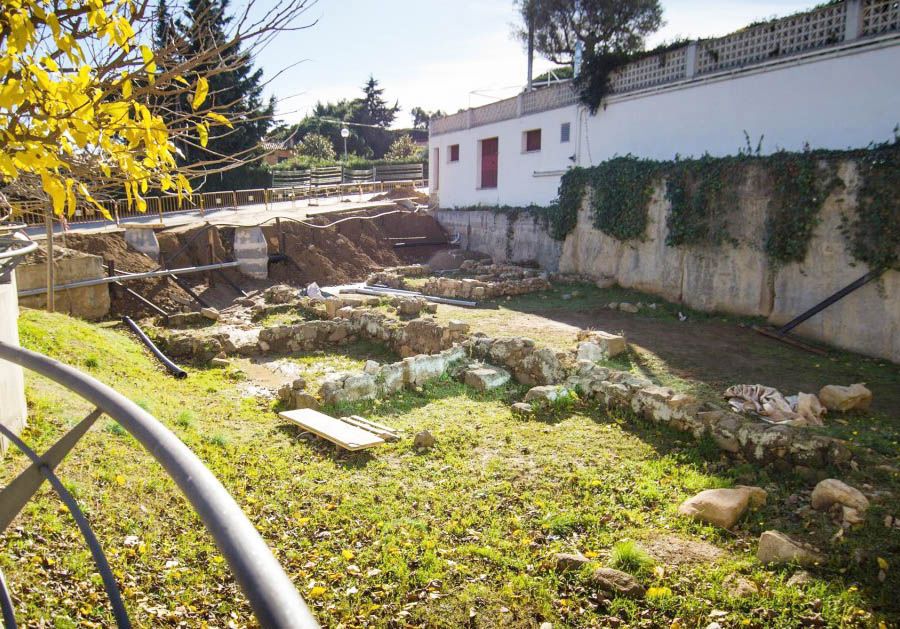
Clos de Ca l’Arnau (Nº2)
Next section of this audioguide, these archaeological remains belong to two superimposed sites.
The oldest and most spectacular site dates from the end of the Republican era and covers about 7,000 square metres although recent excavations suggest a much larger area. They have discovered the most ancient thermal baths known to date in the Iberian Peninsula and are believed to have been in use between the second and firsts centuries BC.
The later site, above the original and covering an area of about 1,000 square metres, belongs to a wine production centre and dates from around the 1st century BC. Nearby they have found other chambers and utility rooms, an oven crucible for smelting, a well and other buildings yet to be excavated.
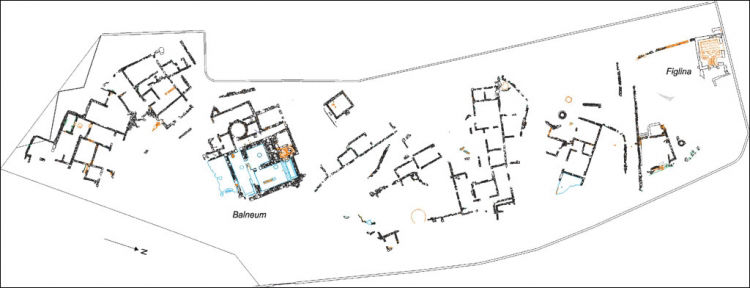
Thermal Baths of Ca l’Arnau (Nº3)
These public thermae that you can visit with the audioguide comprised vast baths with a surface area of about 450 square metres. They had changing rooms or an apodyterium, a warm water hall or tepidarium, a hot water hall or caldarium and a dry sauna or circular Turkish baths. A heating system running from two ovens and a system of cisterns were channelled and distributed beneath the floor. We can still see the stands which held up the ladles used for refreshing themselves. Nearly all the halls were paved and a large part of the walls were plastered and covered with well-preserved tiles.
One of the site’s most relevant elements is the ceiling. It formed a complicated system of vaults and domes with small pieces, tubes or ceramic receptacles which fitted together and at the same time joined again with iron connectors. The whole structure was covered inside with mortar, chalk and sand and on the outside with a final white layer. On the interior one can still make out a variety of classical mouldings which were used to decorate ceiling and walls.
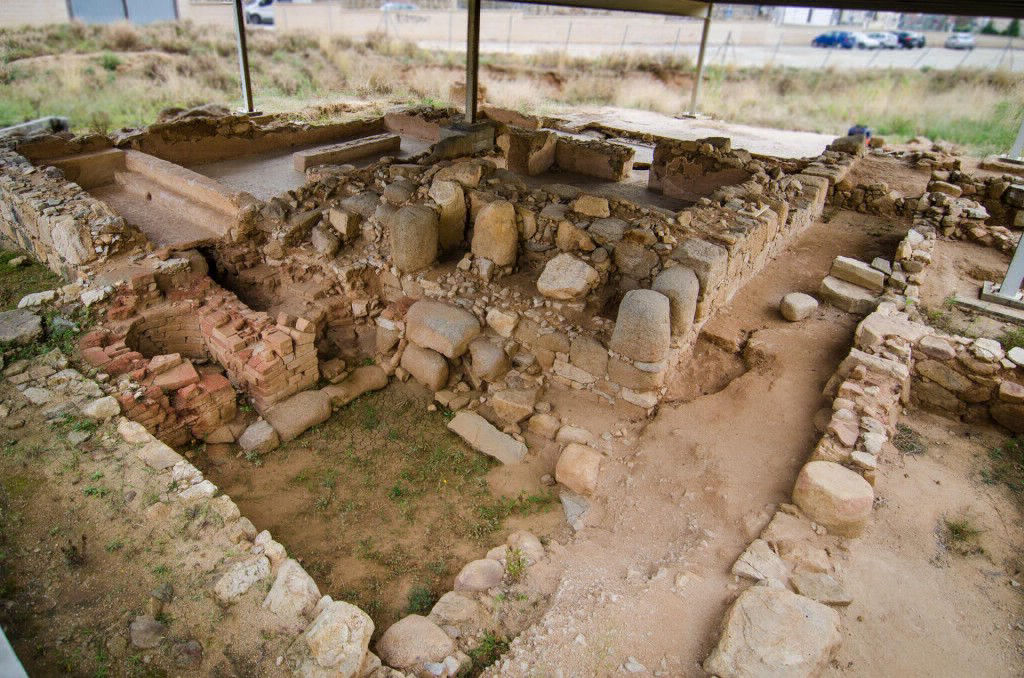
The Ovens of Ca l’Arnau (Nº4)
The existence of this kind of city, together with a period free of armed conflict in the territory, paved the way for the development of an agricultural economy and for integration in a more globalised world on a Mediterranean scale. This meant the beginning of irrigation for the vineyards and the production of enough wine for it to be exported. This new economic engine became especially important in the whole region until the end of the 1st century BC. But it did not affect the urban centre because ILTURO was intentionally abandoned in about the years 80-70 BC, almost certainly coinciding with the founding of the new city of ILURO (what is today Mataró) and the resulting political organisation of the country into municipalities. Nevertheless, during the following years industries for the production and selling of wine, for example the oven for the manufacture of amphorae in Ca l’Arnau, were established on the plot where ancient Ilturo once stood.
The remains of the oven we can see today with the audioguide belong to a wine production centre which dates from around the 1st century BC. It is made up of a very large oven with a double passage for producing amphorae for the storing and transporting of wine, vessels and building materials.
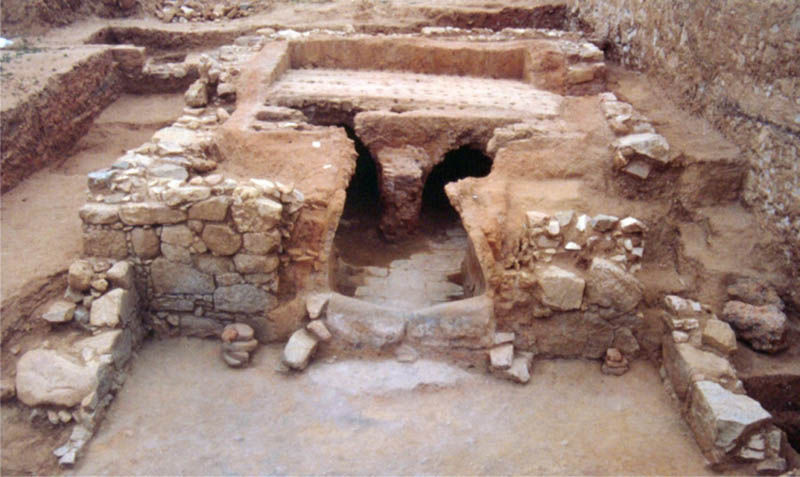
Burriac Castle (Nº5)
The castle you can visit with the audioguide, on the top of Burriac Mountain, belonged to the Counts of Barcelona. They granted it to the Castellvell family and they in turn let it to the knights who borrowed the name of the castle chapel’s patron saint, which also gave its name to Sant Vicenç.
Burriac communicated with the neighbouring castles of La Roca, Dosrius, Bell-lloc and Mata Tower, or Mataró Castle which no longer exists, by means of smoke or fire signals. Nearly all roads, also from the same Iberian era, passed close by.
One can easily distinguish the two enclosures which formed the structure of the Burriac Castle or that of Sant Vicenç: the upper one, the highest and most ancient with its homage tower, and the lower one, used to take in the neighbouring inhabitants in the event of danger.
In the upper enclosure they have found the covered medieval and Roman cisterns, foundations which belonged to some rooms, other residential buildings, a patio and what might possibly have been a strong-room for prisoners. They also discovered the apse which belonged to the Sant Vicenç chapel which was used until the end of the 19th century.
What stands out in the lower enclosure is the fortification which was enlarged to adapt to the area’s terrain. The resultant perimeter was about 160 metres long and the walls between 2 and 3 metres high. There would have been parapets placed at strategic points of the ramparts from which defenders would pour water and boiling oil or throw stones at the attackers.
After countless lawsuits and changes in ownership over the centuries, and eventual abandon, the Cabrera Town Council took over the ownership of the castle in 1990 and started the refurbishment of the fortified complex, resulting in the ruins we can see today with the audioguide.
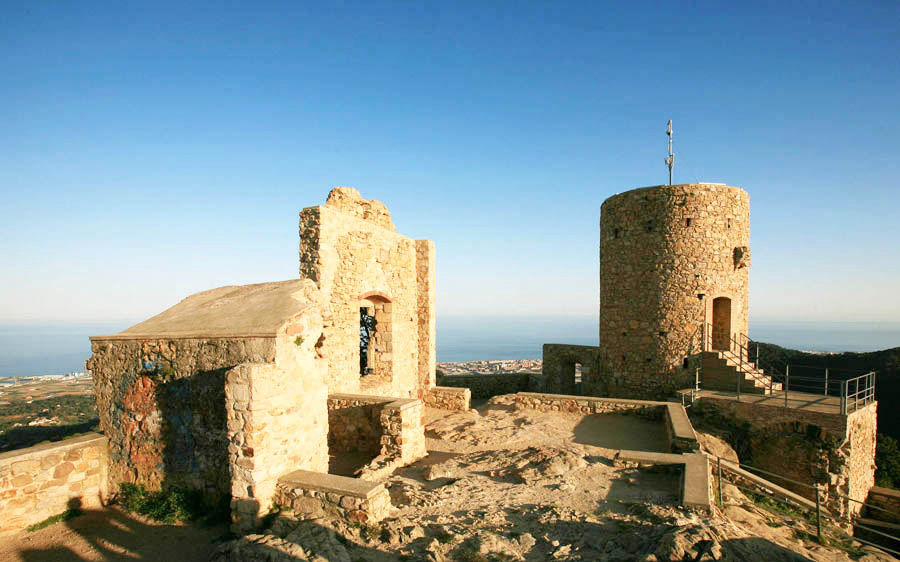
Can Bartomeu (Nº6)
Can Bartomeu is one of the most important country houses in the rural and agricultural history of Cabrera de Mar, and is worth mentionning in this audioguide.
Over the centuries the Bartomeu dynasty became one of the principal families in Cabrera. Towards the mid-19th century they were the biggest landowners in the town, with 58 farms and vast areas of woodland in Burriac and on the Montcabrer.
The main structure dates from 1662, as indicated by the engraved stone at the foot of the entrance, although the original house, which was more modest, is from the 12th century. Not one plot of land in Cabrera was left without vineyards. The country houses became richer than ever and were added to with warehouses, farm buildings, etc., the intention being to exploit them on a multi-family basis for agricultural, cattle and forestry purposes.
The farmhouse suffered numerous attacks from delinquents and bandits at the beginning of the 19th century, resulting in the murder of Feliu Bartomeu, his heir and a maidservant. As a result of these tragic events they contemplated protecting the house by erecting a stone wall with a front façade on which the date of the alterations, 1840, was engraved.
The country house was seriously affected by the phylloxera plague at the end of the 19th century. It was abandoned and then confiscated during the Spanish Civil War when it took in a large number of refugees. This led to the disappearance of most of what still remained of the original furniture.
The country house maintains Gothic, Renaissance, Baroque and Neoclassic architectural features. The tiling, Catalonian spirals and others in the form of handkerchiefs, the original kitchen and cellar with its presses and barrels and period tools all stand out in the interior.
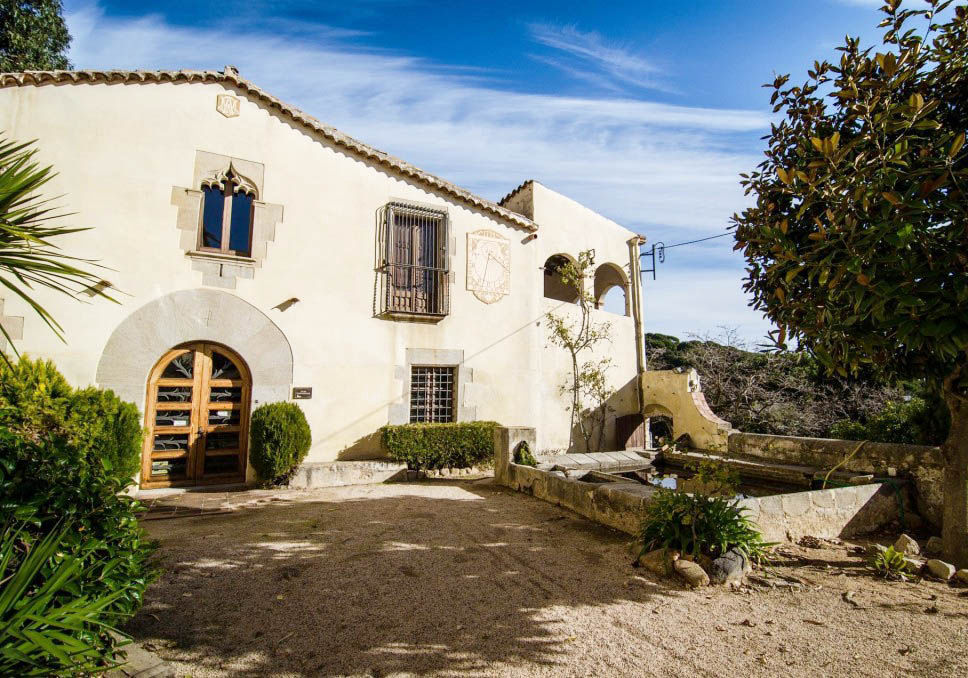
Clos de Can Modolell (Nº7)
Located on the Can Lladó-Modolell estate at the foot of Burriac Mountain, this archaeological site reveals that it was in use and active from the Iberian era to the Lower Middle Ages. It stands out for its high Roman Empire period, with evidence of numerous materials such as ceramics with embossed decorations, ex-votos, or small, inscribed altars.
The most important discoveries, however, are the imposing structures of what must have been a sumptuous palatial villa of uncommon luxury, possibly of Imperial ownership and perfectly adapted to the topography of the terrain, as well as a shrine and various items of worship. To begin with they must have worshipped the God Neptune and an unknown female divinity. Later it became a shrine to Mitra, the sun god of Iranian origins with fertility and health qualities.
The devotion to the Persian God Mitra spread throughout the Empire’s military and merchant classes and was linked to circles of power and influence in the 2nd century BC. It was one of the so-called “mystic religions” which based itself upon the ideal of there being a better life and personal salvation after death. The religious centre of Can Modolell undoubtedly became a very influential instrument of power, control and social unity for the important political and administrative elite of the Romanised ancient Laietan people. The audioguide continues in the next section.
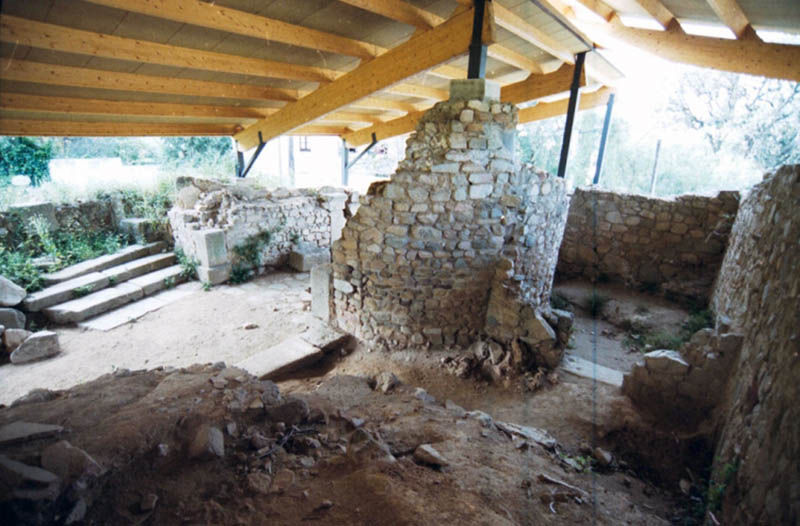
The Church of Sant Feliu (Nº8)
The first church in the town was that of St. John the Baptist, which is now buried under the ancient road, once known as the Can Lladó or Sant Joan road and today as the Can Segarra road, ensuring that the earliest houses in the town were situated around it.
The Sant Feliu church, that you can now see with the audioguide, most probably the second building, is referred to in documents in the year 1025, when it was sold by Conde Berenguer Ramón II.
The Roman building, located at the centre of the town between two river beds and in those days on a hill, consisted of only one nave and would have had as many as three altars. The biggest was dedicated to Saint Feliu and the others to Saint Mary and Saint John the Baptist. The latter boasted an altarpiece painted between 1425 and 1430 by Bernat Martorell, one of the most important artists of Catalonia’s second international Gothic period. Today we can see an exact replica because the original was moved to the Diocesan Museum of Barcelona for restoration and conservation.
In 1540 the increase in population and the need to renovate the old temple led to a new parish being erected. It had a Gothic front with archivolts and foliage with a lower relief by Fèlix Abages, five-turn interior keys, two lateral chapels and a belfry. Emphasis must also be placed upon the variety of Gothic ironwork kept there and the silver processional cross which dates from 1602.
When the Civil War broke out in 1936 the sculptures of Mare de Déu del Roser and of del Carme were burnt as well as that of the Sant Vicenç castle. The front of the church conserves its defences and parapet. There was once a well in the small square in front of the main door and they used to bury plague victims in the lower plain. Today, on the same square, we can see the stone altar which belonged to the old town register. Originally it was situated on the nun’s rise, which is where the priest blessed the town’s four cardinal points, with readings from the four Evangelists.
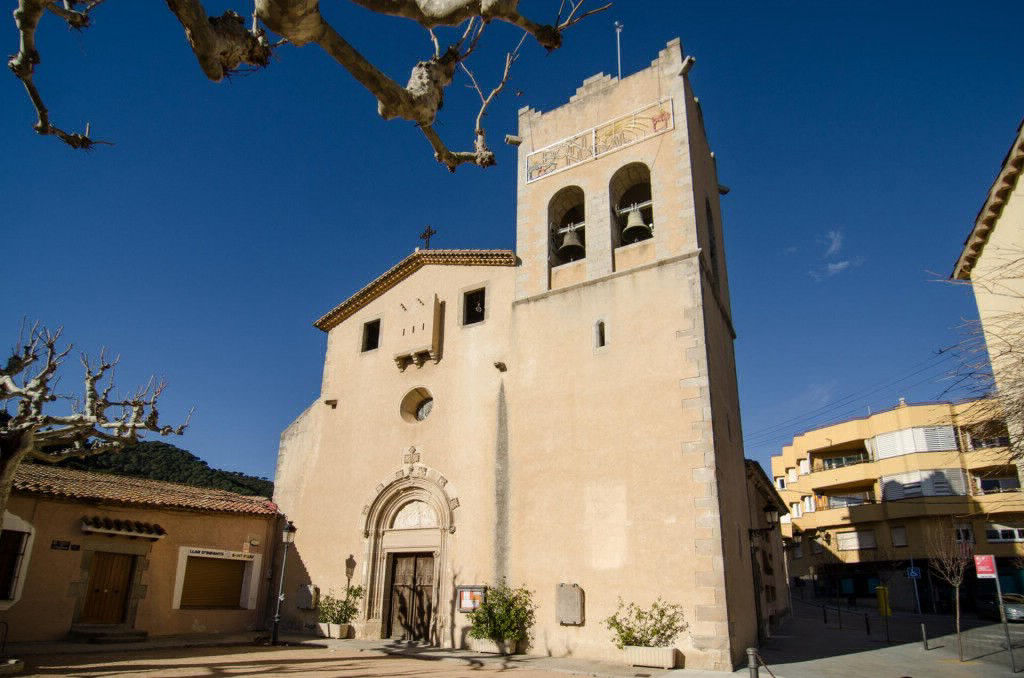
The Cal Conde Country House (Nº9)
In 1024 it was referred to as the “Casa de Cabrera” with Guadall de Sant Vicenç as the first master and founder in the noble dynasty of Cabrera. The earliest date for the house appears to be 1231, with extensions and latter reconstructions. This has caused more than one chronological confusion.
It is also known as can Ros and can Dalmases after the names of their owners, but the name we know it as today is Cal Conde, taking its name from the Count of Vilardaga who purchased the house in 1924.
As a result of numerous refurbishments over the years the building possesses renaissance, baroque, historicist and modernist features. Nevertheless it seems the earliest date of the construction goes back to the Middle Ages. The mansion’s extensions and refurbishments have intended to highlight its class, giving the building an air of nobility. The great pool at the front has got two fountains and a ceramic reproduction of Sant Pau inscribed with the date 1763.
Inside the lintels and jambs stand out as well as 17th century rectangular windows. The coffered ceiling is unique and above all the building’s pièce de resistance, a large, polychrome, ceramic hand basin found in the dining hall. The cellar is also worth mentioning in this audioguide because of its three great vaults.
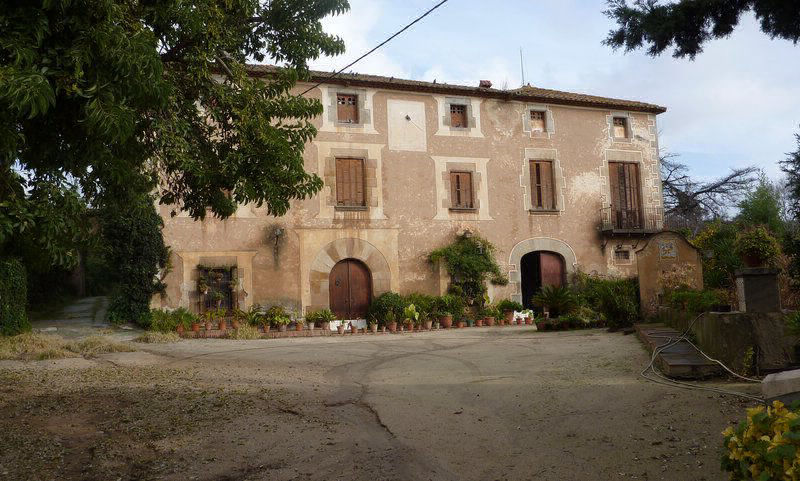
The Town Hall (Nº11)
The new town hall that you can see with the audioguide, designed in 1903 by architect Bonaventura Bassegoda i Amigó, was built bewteen 1928 and 1930. This building, in eclectic-historicist style, is in three parts. It has a raised middle part and three lower levels (basement and two floors) and a double-sloping roof. Noticeable are the symmetrically arranged doors, balcony and rectangular windows with semi-circular arches and lowered arches. There is a porch with three arcades which lead to the lower floor.
Initially the municipal school, with boys and girls kept apart as was the custom in those days, occupied the two lateral wings. There is a mural in the west wing with allegorical features symbolising knowledge, science and progress, values which were exalted in the post-war years of its creation.
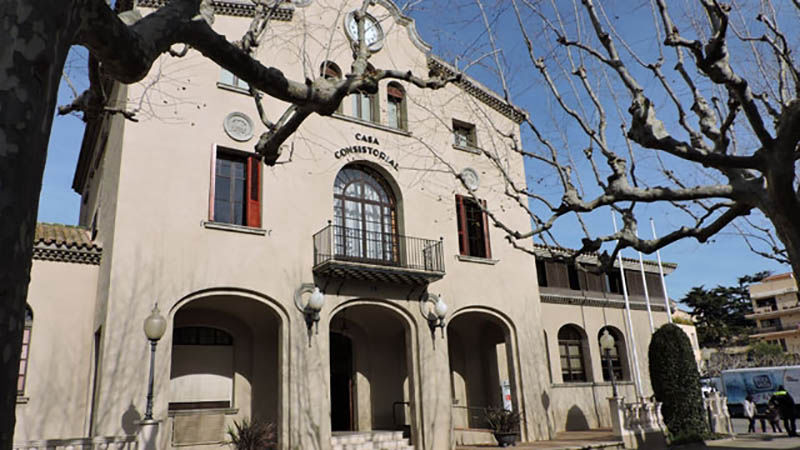
Mas Català (Nº12)
The earliest date recorded for this house is 1294. Later, in 1313, a document mentions the Català family as proprietors of a plot of land in the parish of Cabrera. The country house we have today was probably erected in the 16th or 17th centuries and it betrays renaissance architectural features together with others which are historicist, gothic and modernist. Father Jaume Català, who was a writer and well-known teacher in the Order of the Escolapios, was born in this country house on 3rd January, 1867. In 1901, the Ordeig family of the Cabrera textile industry commissioned architect Joaquim Bassegoda i Amigó to refurbish the house. Prosperity during the previous century had permitted an extension to the estate, adding a farm and an agricultural store. One of the highlights is the vast and splendid enclosed garden in which there is a magnificent hundred-year-old honeyberry tree (the biggest in Cabrera). Access to the garden, as we can see, is through two magnificent modernist doorways, one in Jaume I street and the other in the Padre Jaume Català Avenue. It is also worth mentioning in this audioguide the washing place, the pergola to the west of the estate and, further up, the romantic pond.
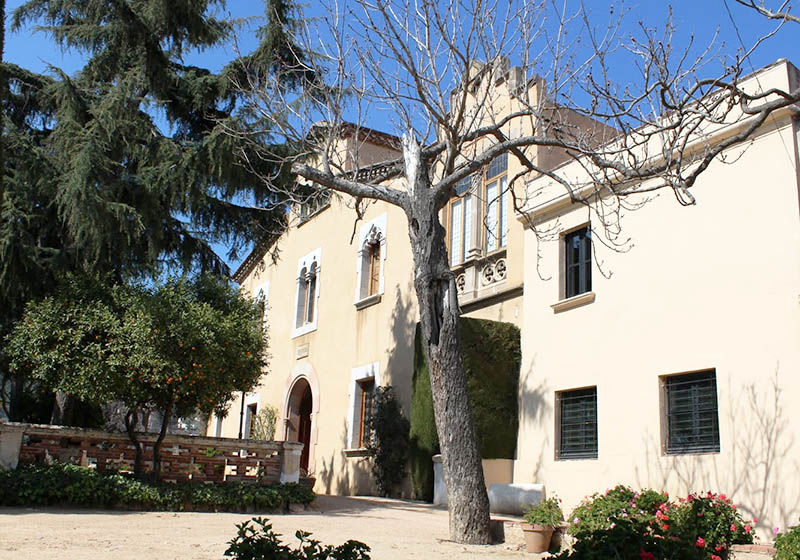
The Plaza del Pueblo Fountain (Nº13)
The Anselm Clavé Street under the town square is probably from the 18th century. It is a layered structure in stone with a hollow at the centre forming a round arch with voussoirs. It is decorated with glazed tiles in the form of diamonds combining dark green with pale yellow. On the left side there is a lion’s mouth from which water pours out to fall onto a ledge. Above this fountain is a plaque commemorating the date when its water began to flow, July 1741. It is almost certain that this fountain communicated with the Santo Domingo aqueduct which is on the Font Picant road.
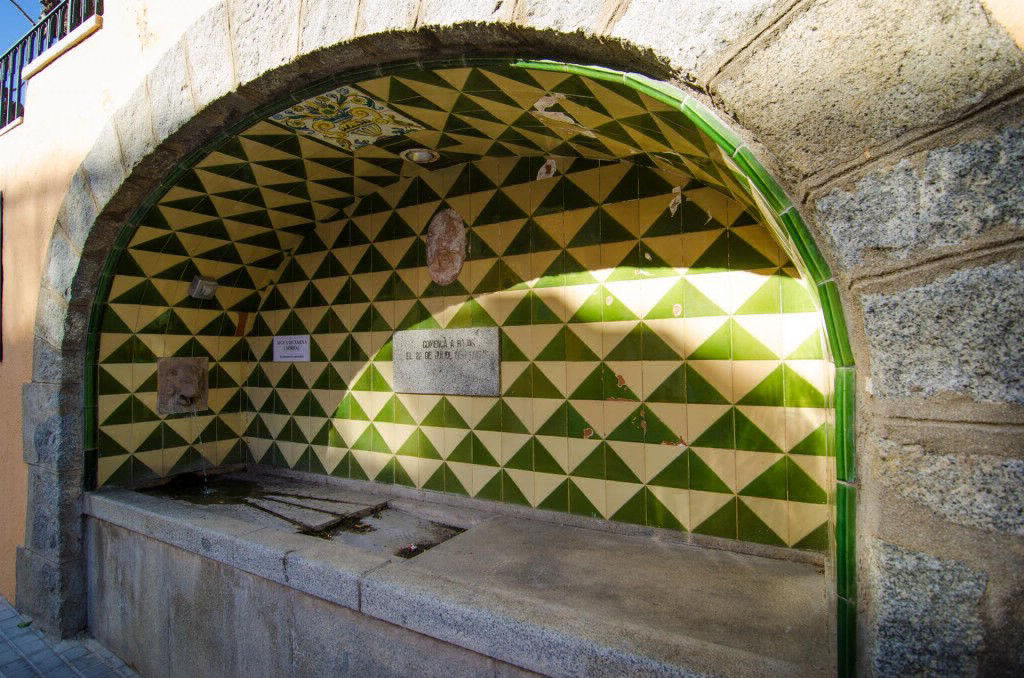
Old Houses in the Town Centre (Nº14)
The streets around the parish church of Sant Feliu began to be developed in medieval times and have existed as far as our day and age almost unchanged. The houses were occupied by families with small businesses or who had leasehold plots of land or vineyards.
Prominent in Anselm Clavé Street is Nº 3. It has a Noucentisme-style façade with sgraffito and brick decorations from 1923 and some floral friezes and sgraffito corner pieces from the end of the 20th century.
Nº 21 belongs to the back entrance of a south-facing estate. It is in neoclassic style and the tympanum in the small, semi-circular pediment dates the construction in 1862.
Nº 23 has a front which has been recently refurbished and it reproduces the previous modernist façade.
Nº 25 was known by the names of Can Simón and Ca la Pepeta del café, and presents an even, ground level façade and two floors.
The last, Nº 27 is a straightforward structure of traditional and simple body with ground floor and terrace roof.
The group of houses on the street descending from the church, with numbers 6, 8, 10, 12 y 14, were refurbished at the beginning of the 20th century and display historicist and modernist features.
The next focus of interest in this audioguide can be found in the town centre of Agell. There are two ways to get there. If you wish to walk, you leave the Tourism Information Point, go up the Padre Jaume Català Avenue and turn right into the Las Monjas rise, joining the Agell road and further on the Santa Elena road.
The other option is to go by car. You leave the Tourism Information Point and go down the Padre Jaume Català Avenue, joining the Once de Septiembre Avenue until you reach a roundabout and take the turning to Argentona. You will reach a point on the B-502 road when you will need to turn into the Santa Elena road until you reach Agell.
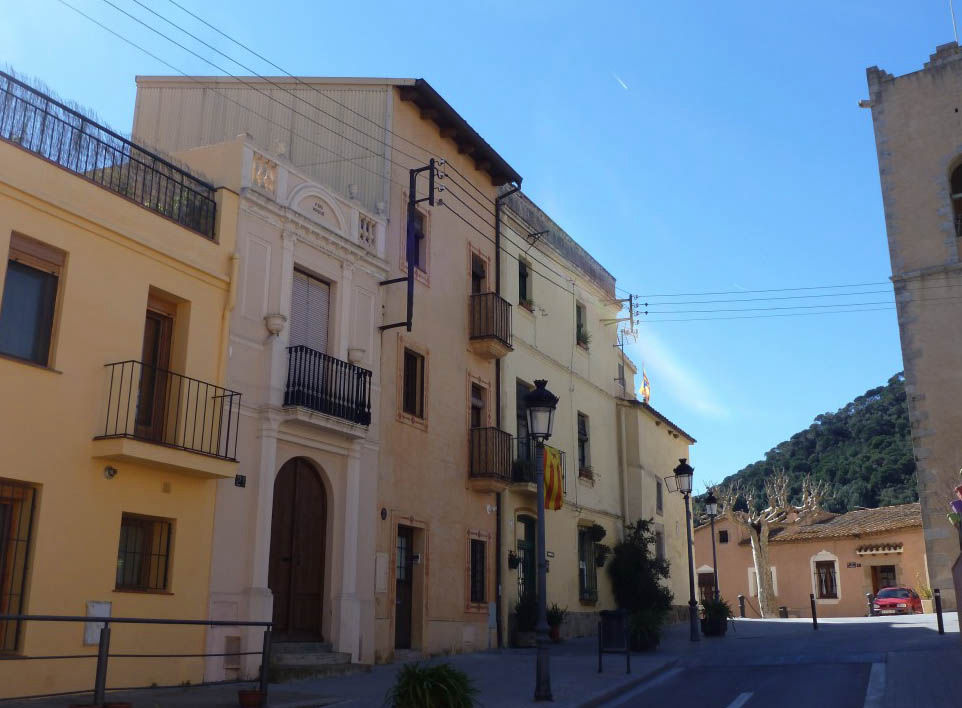
Cemetery and Chapel of Sant Sebastià (Nº15)
Atypical place the audioguide suggests you to visit, the cemetery and Chapel ofSant Sebastià was built in the second half of the 19th century in order to bury the dead from the ancient moat; these are good examples of neoclassic architecture.
The enclosure’s imposing entrance doorway opens up to the façade which leads to the Agell road. It is a great door which has an arched basket-handle vault with various mouldings and on which there is a plinth and cross. To the west side, on the next façade, there is a room with a Catalonian vault.
Various mausoleums and crypts stand out within the enclosure, like that of the Sala family, situated just in front of the main entrance. It is a historicist structure from the early 20th century. Attention should also be brought to an imposing mausoleum, to be found as we go in on the right hand side. It is made entirely of paving stones and has a conical, staggered dome. Architect Domènech i Estapà, lies here and it is quite probable that the design was his own.
In front of this is the grave of poet Antoni Isern. It is a simple burial mound covered with "trencadís" mosaic, a kind of decoration created by joining together fragments of ceramics. Next to the author, who committed suicide at Burriac castle in 1906, is the grave of artist and sculptor Antoni Samarra who also took his own life at the castle and wanted to be buried next to the poet whom he admired.
The San Sebastián Chapel, next to the entrance to the cemetery, was erected in 1507 so as to invoke the saint to protect them against the plagues which were devastating communities in that period.
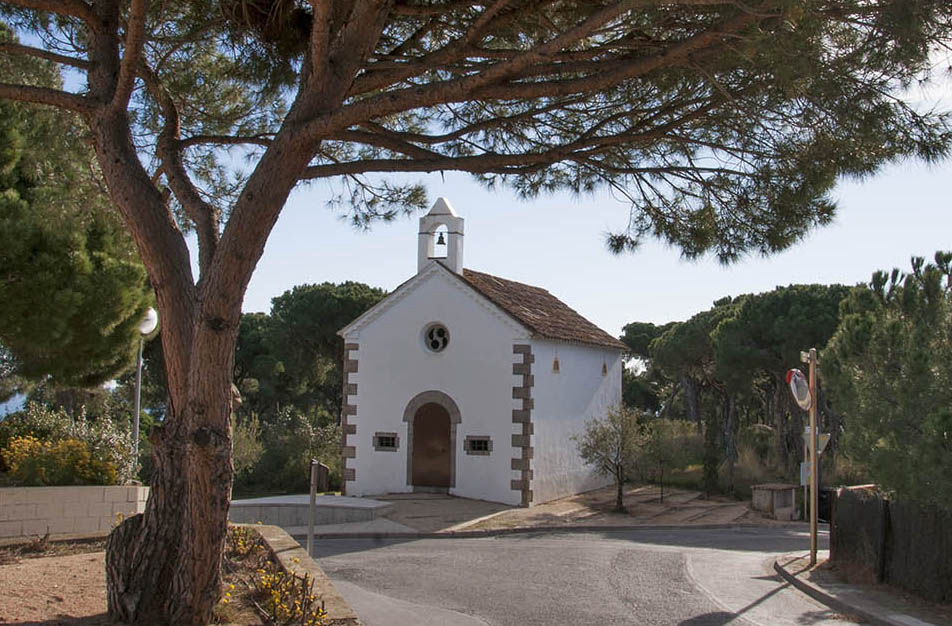
The Chapel of Santa Elena (Nº16)
The town centre Agell de Dalt almost certainly has its origins in a late Roman town which, with the advent of Christianity, must have devoted some of its rooms to private prayer. The chapel today is at the heart of the neighbourhood which is referred to in documents dated in the year 992 as Villam Agelli.
The discovery of the cross of Jesus, an episode which contributed enormously to the spread of worship amongst the first Christians, especially those who began repopulating the Maresme in the 10th century, is attributed to Saint Elena, Emperor Constantius’s concubine and mother of Constantine.
It first appears in documents dated 1236. During the feudal period the Saint Elena chapel was a part of the Agell barracks, which was responsible to the castles of Vilassar and Sant Vicenç, and it was the property of the parish of Sant Feliu.
The primitive chapel was rebuilt in 1576 because it was in danger of falling into ruin. The building we can see today with the audioguide is late gothic in style with just one nave and three bodies with a cross-rib vault. Saint Elena is represented in the keystones with a cross and a book, as well as a goat, and it probably holds some relationship with the heraldic shield of Cabrera de Mar.
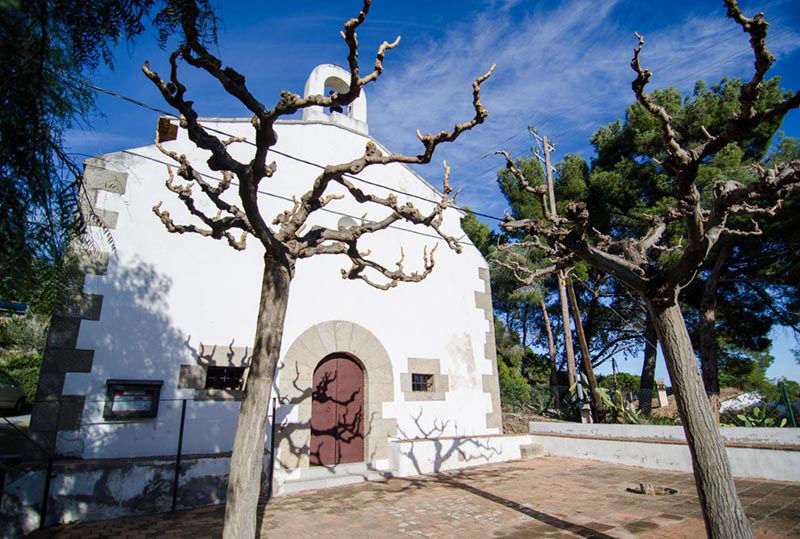
The Tower of Ametller (Nº 18)
This 19th century structure is known by that name because it belonged to Teresa Ametller Cros, the daughter of the chocolate manufacturer, Antoni Ametller.
The building, which was the work of architect Lluís Bonet Garí, maintains all its original features – plastered façades decorated with sgraffito, a semi-circular porch which leads to the entrance and which is surrounded by columns with ionic capitals which hold up an open terrace above the first floor.
There is another covered terrace above an arcaded porch on the opposite side and an almond tree, the original emblem used by the family which owned the building, is depicted on the central voussoir.
It is worth mentioning in this audioguide the bench which is up against one of the lateral walls because it is tiled with frieze ceramics and floral motifs. On the top of the back of the bench there are three illustrations. The central one is of an almond tree and on the outside a girl with a basket of flowers and a peasant. The tower was home to refugees during the Civil War and once the conflict was over the owner was obliged to hand the estate over to the Franco government. It was fitted out by the Female Section of the Social Assistance and was administered by nuns until 1977. Later it became an orphanage before becoming unused for a period of 4 years. Finally the Catalonian Government acquired the property as a youth hostel.
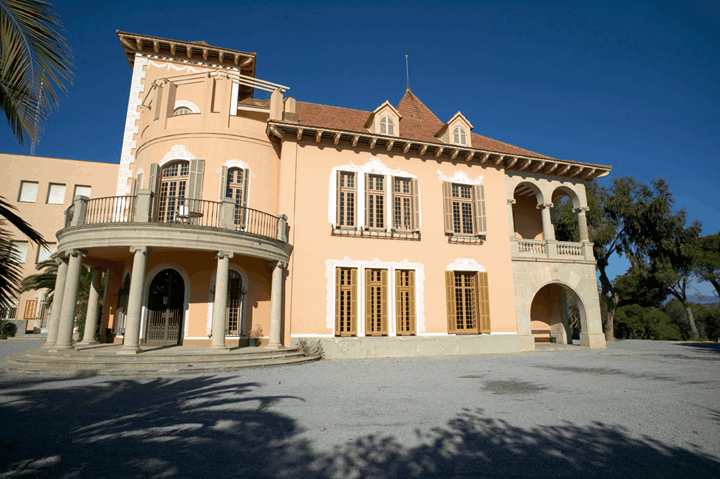
The Can Vivé Country House (Nº19)
The Can Vivé country house is also known as Can Mallol, a characteristic name in the Maresme which means “Novella Vineyard” owing to its tradition as a wine producing estate.
Documented from 1387 it is one of the most important country houses in Cabrera de Mar, architecturally and also because of its size.
Apart from integrating stables with other country houses around the Santa Elena de Agell chapel, Can Mallol formed part of an enclosure with Cals Frares and the road which leads to the Ametller Tower.
The predominant structural features you can see today with the audioguide belong to the 17th century, such as the cellar and the front entrance façade, although the last restoration was in 1974, a date inscribed in roman numerals under the sun dial on the main façade.
The house features the magnificent round doorway with great voussoirs and the windows and granite ashlar corner pieces. We can also find an attractive well in front of the house as well as a mil Stone used for decorative purposes.
The central body of the house structure, with attics on the top floor, is higher than the lateral parts. In later years a hall was added to the rear which acted as a wine cellar and it remained in use until 1959. This cellar is covered with a magnificent, low, basket arched vault and two grand arcades of remarkable capitals.
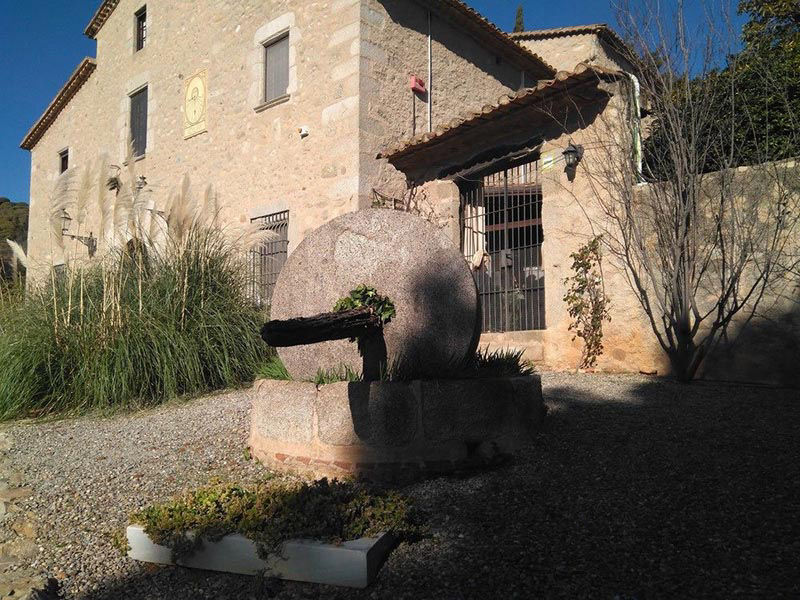
The Cals Frares Country House (Nº58)
Among the oldest documents found in the house, known in the past as Ca l’Arnó, is a testament dated 1235 which belonged to Pere d’Arnó, a peasant in the parish of Sant Feliu de Cabrera. Ca l’Arnó incorporated the stables or a group of neighbourhood houses in Agell which protected each other around the Saint Elena chapel in the 12th century.
In 1687, Brother Joan Bonet was lawyer at the convent of the Camaldolese (Benedictine monks with eremitical tendencies) who occupied the Arnó country house at the time. As a result of the seizure of properties in the middle of the 19th century Cals Frares, as the house was already known, was the object of a private purchase (the coat of arms at the front door includes the year 1843 and the name “Jaume Gallemi”). Soon afterwards it passed into the hands of the Ametller family, the chocolate producers from Barcelona, who used it for sharecropping at the Ametlier Tower which they built nearby. The Ribosa Dellà family, current hereditary owners of the property, moved to Cals Frares as sharecroppers.
The current house, used as a restaurant, features numerous 16th century architectural components as well as renaissance, baroque and neoclassical elements. The building’s façade features the main door with granite voussoirs. Flanking the door is a stone bench to the left and a horseman on the right. Standing out next to this with the audioguide is the magnificent forged ironwork of the window’s grille. The washing place and the well are equally interesting as are the stables’ wooden eating troughs behind the house.
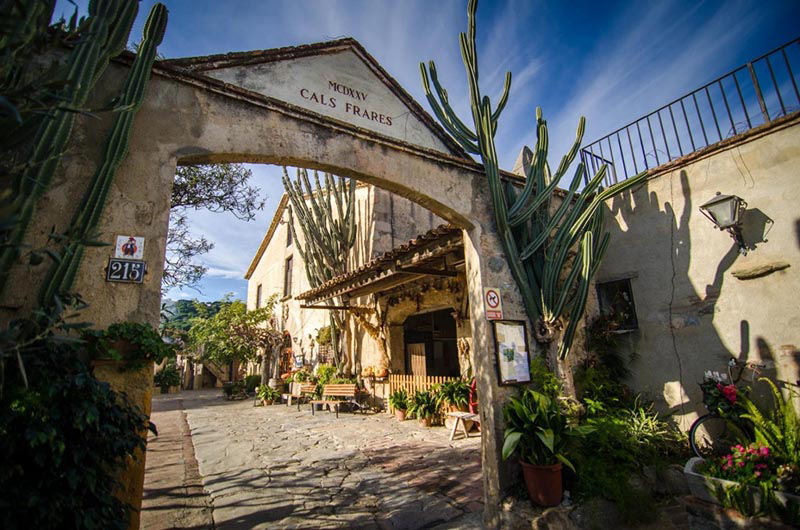
Tourist information centre: Carrer la Riera s/n, 08349 Cabrera de Mar, Barcelona
Tlf: +34 674 01 14 50 - www.gaudeixcabrera.cat -
Back to Index